The Fundamentals of Refractory Inspection with Infrared Thermography
Sonny James
Level I, II & III Certified Infrared Thermographer
Managing Director Thermal Diagnostics Ltd
15 Robertson Street, Les Efforts East, San Fernando, Trinidad and Tobago
868-657-6572
Abstract
Thermography has been used to inspect the condition of refractory lined vessels and piping for many years now. It is a proven and accepted method for locating damaged and missing refractory material. Most companies however, do not fully understand the full benefits of performing refractory surveys. They mainly use thermography only before a plant turnaround to determine the extent of refractory damage in order to estimate the materials and labor needed for the repairs. This paper discusses the fundamentals of refractory inspection and how Thermal Diagnostics Limited has been using Infrared thermography in Trinidad and Tobago as an effective means of predicting areas of future refractory problems in addition to pre-turnaround surveys.
Introduction
First, let me introduce myself to those who do not know me. I am Sonny James, born and raised in Montreal, Canada but now living and working in beautiful Trinidad and Tobago.
I have been doing thermography for the past thirteen years. My first thermographic inspection was helping my father with an electrical survey of a plastic injection factory. He strapped the camera on my shoulder and said, “find me some hot spots!” From that day on, I was fascinated by this remarkable technology.
So, I am here today to talk about refractory inspections. Now, there may be some of you saying to yourselves, “what can a person from Trinidad and Tobago know about inspecting refractory?” And my answer would be this:
The Island of Trinidad may well be considered the capital of refractory lined vessels. Trinidad is the largest producer and exporter of ammonia and methanol in the entire world. To date, we have 10 ammonia plants producing 5.7 million tons per year and 7 methanol plants producing 6.5 million tons per year. Trinidad and Tobago has the two largest methanol plants in the world; ATLAS Methanol that produces 1.7 million tons per year and M5000 that produces 1.8 million tons per year. We also have the largest direct reduced iron (DRI) steel plant in the world (1.4 million ton DRI MidrexTM Megamod) and much, much more. Most of these plants also surpass the technology that is currently found in North America and Europe as they are new, state-of-the-art designs and much more efficient.
The main reason Trinidad and Tobago is the world leader in ammonia and methanol production is due to its abundance of natural gas. In fact, the United States imports approximately 75% of its LNG directly from Trinidad and Tobago.
What is just as amazing is that most of these plants are situated in an area only approximately 4 square miles called the Point Lisas Industrial Estate.
In an average year, I inspect over 20 steam reformers, secondary reformers, boilers, transfer line piping, furnaces, and other refractory lined vessels.
Because Trinidad has so many chemical plants situated so close to each other, it is imperative that high safety standards be put in place. One means of preventing a catastrophic failure is by regularly inspecting equipment with infrared thermography.
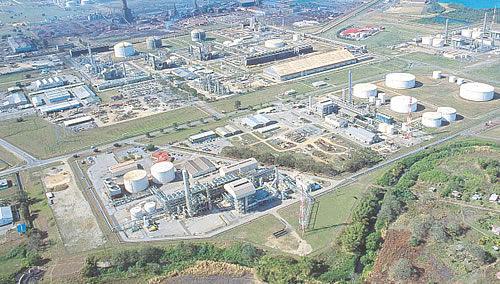 |
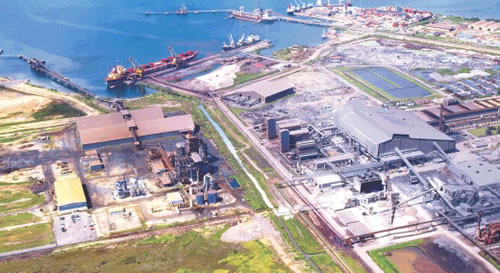 |
|
Aerial Views of Part of the Point Lisas Industrial Estate
|
Discussion
Why Inspect for Refractory Problems?
What many people are unaware of is that the repair cost of refractory lined equipment and the consequences that may occur due to refractory failure greatly exceeds that of rotating machinery and electrical failures. This is mainly because:
-
Repairing refractory lined equipment usually requires a total plant shutdown. This equipment is essential for the process and backups are not available, unlike a motor, pump or MCC breaker that can easily be switched over to a backup with minimal or no production loss.
-
The repair cost of refractory lined equipment is usually hefty, as it requires a lot more manpower labor, heavy equipment, materials and time to effectively carry out repairs.
The main reason a vessel or piping is lined with internal refractory is because the internal temperature is so hot that it will destroy the actual steel shell of the vessel. So, refractory material is installed in order to minimize the heating of the external shell.
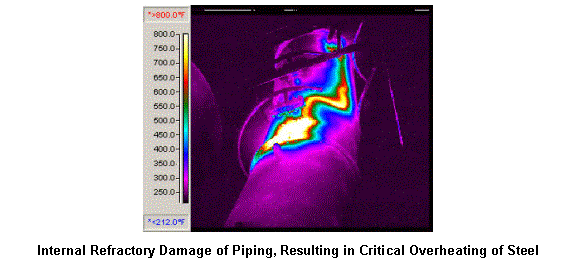
Refractory also ensures that valuable energy is not being wasted and that vessel efficiency is kept at optimum levels.
Refractory comes in various materials and application techniques such as brick, injectable, gunite, etc…
Refractory is also exposed to tremendous stresses during a vessel’s operation. There is a great deal of expansion, contraction, heat, cyclic and convection (wind) stresses inside vessels such as reformers and boilers. There are even some refractory lined equipment that are under high pressures, such as transfer line piping.
All of these stresses can cause refractory failure. When there is refractory failure, there is an inadequate insulating barrier between the extreme internal heat and the weak steel shell. This can lead to a vessel’s shell overheating and burn-through, resulting in dangerous gases, flames and heat exposure. Structural weakening can also occur, with the end result being a catastrophic failure.
When you have a vessel or piping that is under high pressure, you have the dangers of a massive and potentially deadly explosion. It should be noted that when dealing with high-pressure equipment, the maximum allowable temperature of the metal is drastically reduced because of this added stress.
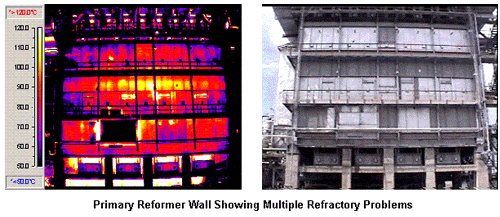
The Inspection: When to Inspect?
Refractory inspection is both an art and a science. Almost all thermographic inspections of refractory are performed while the vessel is operating under normal or full rates. This is because many thermographers and engineers are taught that IR should only be done when the equipment is under an adequate amount of load.
This may be true for electrical and rotating equipment, but nothing can be further from the truth when it comes to refractory.
The fact is that during the start-up cycle of a vessel, it goes through a series of changes in process and temperature that affect the refractory’s behavior. When an IR inspection is conducted during the initial start-up period, you may notice several hot areas. This is usually due to cracks, gaps and voids in the refractory wall. These hot areas should be recorded for future reference, as these are the areas most prone to failure.
With change of process, increased temperature and time during the start-up, you may notice these initial anomalies getting considerably hotter. Some areas may even reach close to critical temperature and even start to show visible signs of overheating on the external shell. These hot spots should also be recorded at this stage. The critical hot spots should also be closely monitored during the course of the start-up.
When the vessel is close to or has reached full rates and temperature, you may notice that most of the hot spots observed during the stages of start-up have reduced in size and temperature. This is because the refractory has properly expanded and sealed off the cracks and gaps.
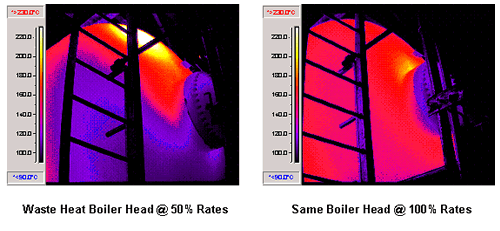
You may also notice that some hot spots have remained. This is because there is some problem with the refractory at that area such as cracks, voids, failure, damage, etc. These problems should be recorded at this particular time, as these will be the majority of hot spots that will be observed during routine inspections while the vessel is under normal operation.
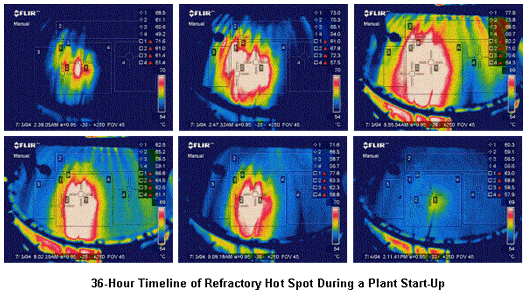
By inspecting refractory during different start-up stages, you have recorded all current problems and you have also recorded potential areas that are susceptible to future problems or failure. You are now on your way to a successful predictive maintenance program for your refractory lined vessels by establishing your baseline data for future trending and monitoring.
Houston, We Have a Problem!
In refractory inspection, as with pretty much almost every other type of equipment inspected, there always comes the dreaded question of “How Hot Is Too Hot?”
Now, when it comes to refractory, there is no one temperature or answer to your overheating problems. Many factors come into play when you’re dealing with a piece of equipment that usually results in total plant shutdown if repairs are to be done. Face it! Plants are in business to make money and the only way they make money is by production. So most of the time, shutting down a vessel for refractory repairs as a result of an excessive hot spot is usually not an option. Certain factors must be weighed first, such as:
-
Safety of plant personnel (I’d like to think that this is #1 on the list)
-
Affects on the equipment and end product
-
Business interruption costs
-
Current market price of the product being produced at the plant
-
And others…
In most cases, overheating sections due to refractory problems can be temporarily overcome and controlled by certain methods. Remember that the main purpose of the refractory is to minimize the amount of heat exposed to the steel shell of the vessel. Therefore, if you no longer have this ability in a certain area due to internal refractory problems, you may be able to control and minimize the overheating on the external surface with the use of steam lances, hoses and spargers and in some cases with a constant flow of water.
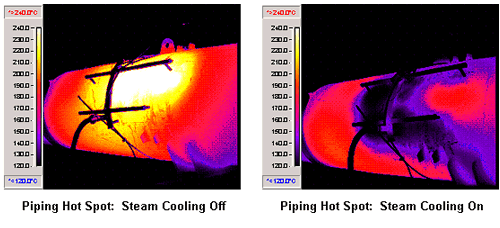
The process of external cooling will keep the shell of the vessel at that area from overheating and failure. The result: being able to keep the plant operational and making money.
It is important to understand that although you now have a way of keeping the area cool via external means, you must still monitor this area on a frequent basis in order to verify that the cooling is effective and that the internal problem is not spreading or worsening. It should also be noted that this approach does not always apply to all critical refractory hot spots. There are some situations that you have no choice but to shut the vessel down to perform repairs. In some cases, you may be able to repair these overheating areas online with injectable refractory and other specialized online refractory repair techniques.
You should also try to inspect and record all repairs in order to maintain a proper trend and database.
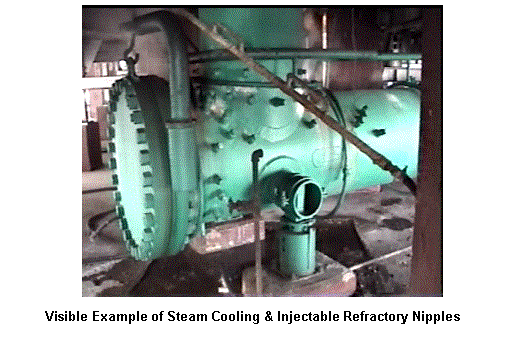
Based on my years of experience inspecting refractory lined equipment, I have established a user defined Delta-T repair criteria that has proven to be quite efficient in prioritizing the severity of most refractory hot spots:
| # 1: 1°C – 35°C (2°F – 63°F): | Indicates a possible minor problem & warrants periodic checks. |
| # 2: 35°C – 70°C (63°F – 126°F): | Indicates problem & warrants periodic monitoring. |
| # 3: 70°C – 100°C (126°F – 180°F): | Indicates concern & warrants frequent monitoring. |
| # 4: >100°C (>180°F): | Indicates high concern & warrants monitoring & corrective measures. |
This Delta-T repair criteria is very conservative and is only used as a guideline for plant engineers to determine what actions are warranted.
Ultimately, the deciding factor as to exactly “How Hot is Too Hot” is unique for every type of equipment. It is recommended that accurate Absolute temperatures be documented in order to reference with the maximum allowable shell temperature for that particular piece of equipment. It is only from these Absolute temperatures that an effective course of action can be taken.
Identification of Refractory Problems
When inspecting refractory lined piping such as a transfer line, locating and identifying problems due to refractory failure is fairly simple as there are usually no internal structures within the piping that may confuse the thermographer.
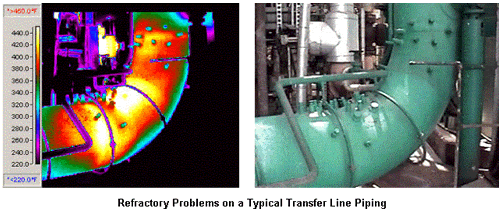
However, when inspecting vessels such as steam reformers, boilers, heaters, etc., it is important to know what the internal make-up of each vessel is. Internal supports and structures such as brackets, beams, trays, tubes and bolts that are attached to the shell of the vessel may actually be thermally visible during the inspection. This is because of heat conduction. So, knowing what is inside a vessel can help you in your analysis and diagnosis of your inspection.

There are also certain areas within every vessel that are prone to refractory failure. Vessels are mainly designed by their functional or operational characteristics. Although the design of a vessel does accommodate refractory installation, there is no cost-effective way to design a vessel to be fully refractory failure-proof. Some areas on vessels that are prone to refractory failure are:
-
Welded joint sections
-
Corners and seams
-
Man-way sections
-
Top 180° of piping
-
Roofs
-
Opening areas such as sight-ways and ports
-
Burner areas
Although these are the most common places where refractory failure occurs, it is not uncommon to have problems and failures on the vertical wall sections and bottom flooring.
It is important to inspect every accessible part of a vessel and piping in order to perform an effective refractory inspection. That is why it is important to take your time and inspect in a systematic way, making sure everything is inspected because the area you missed will quite often be the area that fails. It’s good practice to first perform a walk-through of the entire vessel or piping system before turning on your imager. By doing this before your survey you benefit from:
-
Knowing how and where to start the inspection and what route to take
-
Identifying potentially unsafe and hazardous conditions
-
Identifying visibly noticeable problems and flagging them for your IR inspection
Conclusion
With the highly competitive markets out there, it is important to keep your production costs down as well as try to prevent equipment failures.
By using Infrared Thermography actively and frequently on refractory lined equipment, you are in a better position to “predict” problems, keep your equipment running during problem times and also properly schedule repairs and estimate the total materials needed for these repairs.
The notions that refractory inspections should only be performed just before a scheduled plant turnaround in order to estimate repairs or be performed only when a visible problem is evident should be reviewed. Most refractory lined equipment is critical to your plant’s operation and should therefore be monitored on a regular basis.
You can establish an effective “Predictive Maintenance” program for your equipment!
Advertisement


